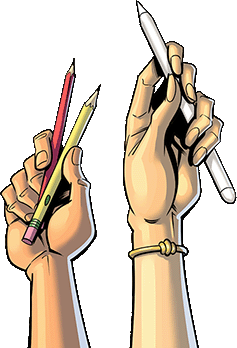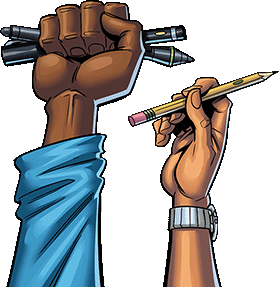Making Digital Comics: Setting Your Page Size and Resolution
September 7, 2022
In large publishing houses that work with comic books and graphic artists, independent production teams usually work on the comic page format. This process involves setting the page and resolution before the comic goes live or is sent to print.
Many professional comic book artists and writers don’t know about the comic book page format because they don’t manage that particular task. However, learning how to set your standard comic page size and resolution correctly can save you money and help you maintain creative control over your project. Contact Comix Well Spring if you have any questions about comic page sizes.
Handing over a completed, properly sized file will make the journey from idea to inception a smoother and quicker process. Here’s what you need to know about page sizes and resolution when making a digital comic.
Pixels Per Inch (PPI)
These days, most online and physical comics are created digitally. Artwork is scanned into computers and manipulated through editing software. To get a crisp, clean image with excellent shading, detail, and color, you need to ensure your images are set to the right pixels per inch (PPI).
A higher PPI indicates a greater pixel density, translating to a higher-quality image on your screen. It also allows readers to zoom into your comic without losing quality. After spending weeks or even months on your comic, ensure the reader can enjoy the artwork fully by using quality images. Comic page size pixels are also important if you plan to print your work.
Setting Your Digital Page Resolution
By opting for higher comic book size pixels in digital format, you won’t need to make major adjustments to the webcomic size when preparing to print. For high-quality digital comics that are print-ready, aim for a digital resolution of 400 PPI.
Dots Per Inch (DPI)
When the time comes to print your digital comic, your focus switches from PPI to DPI (dots per inch).
A printer creates an image by depositing tiny dots of color onto a page. The more dots the printer lays down, the clearer the image; this is referred to as resolution. A high-resolution image looks crisp and clear because the accumulation of dots captures the minute details. Lower resolution images have more space between each printed dot, so they’re fuzzier.
Large print items like billboards use low-resolution images because they’re viewed from a distance, negating the need for fine details. When working with smaller art-size pieces, like comic book strips or graphic novel imagery, high-resolution images ensure every detail of the artwork can be enjoyed.
Setting Your Print Page Resolution
Aim for a resolution of at least 400 DPI for the highest-quality prints. You can go higher theoretically, but this is not always an option. Most offset printers can only handle 400 DPI, limiting the quality of your prints. Storing high-resolution images can also be an issue as they take up a large chunk of your computer’s hard drive.
Many professional publication houses, including Dark Horse, print their comics at 400 DPI. Therefore, going beyond this level of resolution isn’t necessary, especially if you’re an amateur artist. 400 DPI provides a clear delineation between detailed sections of the page, like cells and text bubbles.

Setting Your Comic Book Page Size
In digital form, full-color comic book files are compressed, allowing readers to access them without waiting too long for the pages to load. Compressed files also download quickly and don’t take up too much memory on a phone or computer hard drive. Digital comics should be reduced to 1MB to 2.5MB PDFs.
When printing your comic, it’s important to consider the page size. The term print size describes the final size of a printed page. After scanning your images, they will have to be scaled to fit correctly.
Higher DPI images are usually easier to scale as the concentration of dots creates a much sharper image. Low-resolution images get increasingly blurry the more you increase their size.
For example, if you scan something that is 5.5 x 8.5 inches but want a print size of 11 x 8 inches, you will need to double the scale for your final print. If this image is scanned at 72 DPI, it will be blurry, even if it was clear when you first scanned it. You must account for size and resolution when you put your comic together ahead of printing.
What Size are Comic Book Pages?
The standard American comic page size is 6.875 by 10.438 inches with bleed. The print bleed is the part of the sheet that goes beyond the edge of the page. Essentially, the initial artwork is larger than the print size to prevent white strips from appearing on the edge of the page.
This provides a safe area that can be trimmed down to provide a consistent and colorful final product. Once it has been trimmed, an American comic book paper size is 6.625 by 10.187 inches. If you plan to print your digital comics, set your page trim size to the U.S. standard, as it is most familiar to readers and collectors.
Publish Your Digital Creations with Comix Well Spring
If you’re a comic book artist or aspiring to be one; it’s crucial to understand the terms and layout of a comic book, especially comic paper size, pixels per inch, and dots per inch. The more you know, the more you can retain control over your finished project, and the more professional it will look.
Comix Well Spring can help you print beautiful, professional comic books. We have an array of paper options and sizes, as well as resolution sizes. We also offer free comic templates if you’re struggling to format your work the way you want to.


